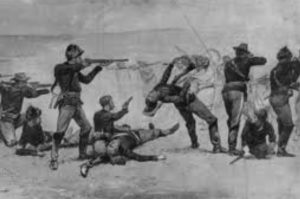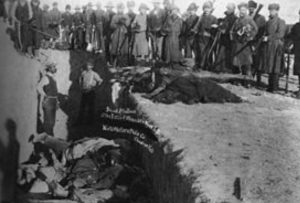 We hear many things about the different Indian Wars and battles. We also know that many of these wars were unnecessary, and were largely due to broken treaties that were made between the White Man and the Indians. Because the population of the United States was inevitable, I don’t know how we could have possibly left so much land exclusively for the use if the Indians, but there must have been better ways to work this out. Nevertheless, once a population explosion starts, it is impossible to stop it.
We hear many things about the different Indian Wars and battles. We also know that many of these wars were unnecessary, and were largely due to broken treaties that were made between the White Man and the Indians. Because the population of the United States was inevitable, I don’t know how we could have possibly left so much land exclusively for the use if the Indians, but there must have been better ways to work this out. Nevertheless, once a population explosion starts, it is impossible to stop it.
Of further concern to the government were the spiritual beliefs of the Indians. Throughout 1890, the United States government worried about the increasing influence at Pine Ridge of the Ghost Dance spiritual movement. The movement taught that the Indians had been defeated and confined to reservations because they had angered the gods by abandoning their traditional customs. This movement prompted many Sioux Indians to believed that if they practiced the Ghost Dance and rejected the ways of the white man, the gods would create the world anew and destroy all non-believers, including non-Indians.
The situation escalated when on December 15, 1890, reservation police tried to arrest Sitting Bull, the famous Sioux chief, because they mistakenly believed he was a Ghost Dancer. In the process of his arrest, they killed him, thereby increasing the tensions at Pine Ridge. Then, on December 29, the U.S. Army’s 7th Cavalry surrounded a band of Ghost Dancers under Big Foot, a Lakota Sioux chief, near Wounded Knee Creek. They demanded the Indians surrender their weapons. Immediately, a fight broke out between an Indian and a U.S.  soldier. A shot was fired, but it’s unclear who fired first. A brutal massacre followed, in which it’s estimated that between 150 and 300 Indians were killed, nearly half of them women and children. The cavalry lost 25 men. The conflict at Wounded Knee was originally referred to as a battle, but in reality it was a tragic and avoidable massacre. Surrounded by heavily armed troops, it’s unlikely that Big Foot’s band would have intentionally started a fight. Some historians speculate that the soldiers of the 7th Cavalry were deliberately taking revenge for the regiment’s defeat at Little Bighorn in 1876. Whatever the motives, the massacre ended the Ghost Dance movement and was the last major battle in America’s deadly war against the Plains Indians.
soldier. A shot was fired, but it’s unclear who fired first. A brutal massacre followed, in which it’s estimated that between 150 and 300 Indians were killed, nearly half of them women and children. The cavalry lost 25 men. The conflict at Wounded Knee was originally referred to as a battle, but in reality it was a tragic and avoidable massacre. Surrounded by heavily armed troops, it’s unlikely that Big Foot’s band would have intentionally started a fight. Some historians speculate that the soldiers of the 7th Cavalry were deliberately taking revenge for the regiment’s defeat at Little Bighorn in 1876. Whatever the motives, the massacre ended the Ghost Dance movement and was the last major battle in America’s deadly war against the Plains Indians.


Leave a Reply